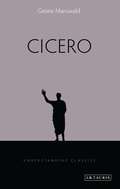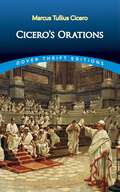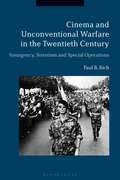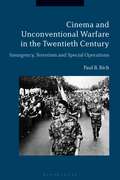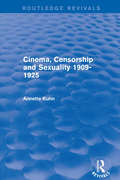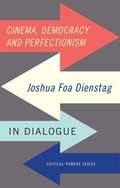- Table View
- List View
The Cia And American Democracy: (pdf)
by Rhodri Jeffreys-JonesThis third edition of Rhodri Jeffreys-Jones’s engrossing history of the Central Intelligence Agency includes a new prologue that discusses the history of the CIA since the end of the Cold War, focusing in particular on the intelligence dimensions of the terrorist attacks on 9/11. Praise for the earlier editions: “I have read many books on the CIA, but none more searching and still dispassionate. Nor would I have believed that a book of such towering scholarship could still be so lucid and exciting to read.”—Daniel Schorr “This is one of the best short histories of the CIA in print, up-to-date and based on a wide range of sources.”—Walter Laqueur “Judicious and reasonable. . . . A sophisticated study that should challenge us to take a more serious view about how our democracy formulates its foreign policy.”—David P. Calleo, New York Times Book Review A brief, yet subtle and penetrating, account of the Central Intelligence Agency."—Leonard Bushkoff, Christian Science Monitor "Subtle and crisply written. . . . A book remarkable for its clarity and lack of bias."—William W. Powers, Jr., International Herald Tribune, Paris
The CIA and the Congress for Cultural Freedom in the Early Cold War: The Limits of Making Common Cause (Studies in Intelligence)
by Sarah Miller HarrisThis book questions the conventional wisdom about one of the most controversial episodes in the Cold War, and tells the story of the CIA's backing of the Congress for Cultural Freedom. For nearly two decades during the early Cold War, the CIA secretly sponsored some of the world’s most feted writers, philosophers, and scientists as part of a campaign to prevent Communism from regaining a foothold in Western Europe and from spreading to Asia. By backing the Congress for Cultural Freedom, the CIA subsidized dozens of prominent magazines, global congresses, annual seminars, and artistic festivals. When this operation (QKOPERA) became public in 1967, it ignited one of the most damaging scandals in CIA history. Ever since then, many accounts have argued that the CIA manipulated a generation of intellectuals into lending their names to pro-American, anti-Communist ideas. Others have suggested a more nuanced picture of the relationship between the Congress and the CIA, with intellectuals sometimes resisting the CIA's bidding. Very few accounts, however, have examined the man who held the Congress together: Michael Josselson, the Congress’s indispensable manager—and, secretly, a long time CIA agent. This book fills that gap. Using a wealth of archival research and interviews with many of the figures associated with the Congress, this book sheds new light on how the Congress came into existence and functioned, both as a magnet for prominent intellectuals and as a CIA operation. This book will be of much interest to students of the CIA, Cold War History, intelligence studies, US foreign policy and International Relations in general.
The CIA and the Congress for Cultural Freedom in the Early Cold War: The Limits of Making Common Cause (Studies in Intelligence)
by Sarah Miller HarrisThis book questions the conventional wisdom about one of the most controversial episodes in the Cold War, and tells the story of the CIA's backing of the Congress for Cultural Freedom. For nearly two decades during the early Cold War, the CIA secretly sponsored some of the world’s most feted writers, philosophers, and scientists as part of a campaign to prevent Communism from regaining a foothold in Western Europe and from spreading to Asia. By backing the Congress for Cultural Freedom, the CIA subsidized dozens of prominent magazines, global congresses, annual seminars, and artistic festivals. When this operation (QKOPERA) became public in 1967, it ignited one of the most damaging scandals in CIA history. Ever since then, many accounts have argued that the CIA manipulated a generation of intellectuals into lending their names to pro-American, anti-Communist ideas. Others have suggested a more nuanced picture of the relationship between the Congress and the CIA, with intellectuals sometimes resisting the CIA's bidding. Very few accounts, however, have examined the man who held the Congress together: Michael Josselson, the Congress’s indispensable manager—and, secretly, a long time CIA agent. This book fills that gap. Using a wealth of archival research and interviews with many of the figures associated with the Congress, this book sheds new light on how the Congress came into existence and functioned, both as a magnet for prominent intellectuals and as a CIA operation. This book will be of much interest to students of the CIA, Cold War History, intelligence studies, US foreign policy and International Relations in general.
The Cia And The U.S. Intelligence System
by Scott BreckinridgeForeign policy—including economic policy and national security policy—and the appropriate planning, decisionmaking, and execution of that policy depend upon foreign intelligence, which must be collected on a global scale, checked, compared, sifted, analyzed, and coordinated. The collection, analysis, and delivery of this body of information require
The Cia And The U.S. Intelligence System
by Scott BreckinridgeForeign policy—including economic policy and national security policy—and the appropriate planning, decisionmaking, and execution of that policy depend upon foreign intelligence, which must be collected on a global scale, checked, compared, sifted, analyzed, and coordinated. The collection, analysis, and delivery of this body of information require
The Cia's Secret Operations: Espionage, Counterespionage, And Covert Action
by Harry RositzkeI am grateful to those of my colleagues in this first generation of American "spymasters" who were willing to share their experiences with me even after I retired to my unclassified farm . I am indebted to Howard Roman , who worked with Allen Dulles on his intelligence writings , for his assistance in the preparation of the early chapters, and to Nancy Kelly, my editor at Reader's Digest Press , for the sharp edge of her pruning shears .
The Cia's Secret Operations: Espionage, Counterespionage, And Covert Action
by Harry RositzkeI am grateful to those of my colleagues in this first generation of American "spymasters" who were willing to share their experiences with me even after I retired to my unclassified farm . I am indebted to Howard Roman , who worked with Allen Dulles on his intelligence writings , for his assistance in the preparation of the early chapters, and to Nancy Kelly, my editor at Reader's Digest Press , for the sharp edge of her pruning shears .
Cicero: Philippics 7-14 (Understanding Classics #507)
by Gesine ManuwaldMarcus Tullius Cicero (106-43 BCE) introduced Romans to the major schools of Greek philosophy, forging a Latin conceptual vocabulary that was entirely new. But for all the sophistication of his thinking, it is perhaps for his political and oratorical career that Cicero is best remembered. He was the nemesis of Catiline, whose plot to overthrow the Republic he famously denounced to the Senate. He was the selfless Consul who turned down the opportunity to join Julius Caesar and Pompey in their ruling triumvirate with Crassus. He was briefly Rome's leading man after Caesar's assassination in 44 BCE. And he was the indecisive schemer whose personal ambitions and bitter rivalry with Mark Antony led to his own violent death in 43 BCE as an enemy of the state. In her authoritative survey, Gesine Manuwald evokes the many faces of Cicero, as well as his complexities and seeming contradictions. She focuses on his major writings, allowing the great rhetorician to speak for himself. Cicero's rich legacy is seen to endure in the works of Plutarch and Quintilian as well as in the speeches of Winston Churchill and Barack Obama.
Cicero, Classicism, and Popular Culture
by Marshall FishwickLearn why Cicero is considered one of the most important individuals in all of Western culture!Marcus Tullius Cicero (106-43 BC) was a poet, philosopher, writer, scholar, barrister, statesman, patriot, and the linguist who helped make Latin into a universal language. His many influences in rhetoric, politics, literature, and ideas are seen throughout Western civilization. Cicero, Classicism, and Popular Culture explores the fascinating man behind the eloquence and his monumental effect on language, morality, and popularity of Western culture. One of the leading authorities on popular culture, Dr. Marshall Fishwick discusses the multifaceted man who may be, besides Jesus, the central figure in all of Western civilization.The author recounts his own personal quest of traveling the land and ancient cities of Italy, gleaning insights from people he met along the way who have knowledge about Cicero&’s life and times. However, Cicero, Classicism, and Popular Culture is more than a simple search for the man and his accomplishments, a man whose mere words changed the way people think. This book shows in each of us the roots of our own ideas, beliefs, and culture. Cicero, Classicism, and Popular Culture discusses: Cicero&’s rise to acclaim his affect on the language of popular culture common traits Cicero shared with Thomas Jefferson rhetoric, the art of oratory community two pivotal essays on friendship and old age vision of his reputation the search for peace Marshall McLuhan, Ciceronian Cicero&’s Rome Cicero&’s ancestral home of Arpinum Julius Caesar, politics, and the influences of Cicero the Roman republic and its downfall America as the new Rome much more!Cicero, Classicism, and Popular Culture is a startling, entertaining examination of the man who made Western culture what it is today. The book is insightful reading for educators, students, or anyone interested in one of the major forces in popular culture.
Cicero, Classicism, and Popular Culture
by Marshall FishwickLearn why Cicero is considered one of the most important individuals in all of Western culture!Marcus Tullius Cicero (106-43 BC) was a poet, philosopher, writer, scholar, barrister, statesman, patriot, and the linguist who helped make Latin into a universal language. His many influences in rhetoric, politics, literature, and ideas are seen throughout Western civilization. Cicero, Classicism, and Popular Culture explores the fascinating man behind the eloquence and his monumental effect on language, morality, and popularity of Western culture. One of the leading authorities on popular culture, Dr. Marshall Fishwick discusses the multifaceted man who may be, besides Jesus, the central figure in all of Western civilization.The author recounts his own personal quest of traveling the land and ancient cities of Italy, gleaning insights from people he met along the way who have knowledge about Cicero&’s life and times. However, Cicero, Classicism, and Popular Culture is more than a simple search for the man and his accomplishments, a man whose mere words changed the way people think. This book shows in each of us the roots of our own ideas, beliefs, and culture. Cicero, Classicism, and Popular Culture discusses: Cicero&’s rise to acclaim his affect on the language of popular culture common traits Cicero shared with Thomas Jefferson rhetoric, the art of oratory community two pivotal essays on friendship and old age vision of his reputation the search for peace Marshall McLuhan, Ciceronian Cicero&’s Rome Cicero&’s ancestral home of Arpinum Julius Caesar, politics, and the influences of Cicero the Roman republic and its downfall America as the new Rome much more!Cicero, Classicism, and Popular Culture is a startling, entertaining examination of the man who made Western culture what it is today. The book is insightful reading for educators, students, or anyone interested in one of the major forces in popular culture.
Cicero, Philippic 2, 44–50, 78–92, 100–119: Latin Text, Study Aids with Vocabulary, and Commentary (Classics Textbooks #6)
by Ingo GildenhardCicero composed his incendiary Philippics only a few months after Rome was rocked by the brutal assassination of Julius Caesar. In the tumultuous aftermath of Caesar’s death, Cicero and Mark Antony found themselves on opposing sides of an increasingly bitter and dangerous battle for control. Philippic 2 was a weapon in that war. Conceived as Cicero’s response to a verbal attack from Antony in the Senate, Philippic 2 is a rhetorical firework that ranges from abusive references to Antony’s supposedly sordid sex life to a sustained critique of what Cicero saw as Antony’s tyrannical ambitions. Vituperatively brilliant and politically committed, it is both a carefully crafted literary artefact and an explosive example of crisis rhetoric. It ultimately led to Cicero’s own gruesome death. This course book offers a portion of the original Latin text, vocabulary aids, study questions, and an extensive commentary. Designed to stretch and stimulate readers, Ingo Gildenhard’s volume will be of particular interest to students of Latin studying for A-Level or on undergraduate courses. It extends beyond detailed linguistic analysis to encourage critical engagement with Cicero, his oratory, the politics of late-republican Rome, and the transhistorical import of Cicero’s politics of verbal (and physical) violence.
Cicero, Philippic 2, 44–50, 78–92, 100–119 Latin text, study aids with vocabulary, and commentary (PDF)
by Ingo GildenhardCicero composed his incendiary Philippics only a few months after Rome was rocked by the brutal assassination of Julius Caesar. In the tumultuous aftermath of Caesar’s death, Cicero and Mark Antony found themselves on opposing sides of an increasingly bitter and dangerous battle for control. Philippic 2 was a weapon in that war. Conceived as Cicero’s response to a verbal attack from Antony in the Senate, Philippic 2 is a rhetorical firework that ranges from abusive references to Antony’s supposedly sordid sex life to a sustained critique of what Cicero saw as Antony’s tyrannical ambitions. Vituperatively brilliant and politically committed, it is both a carefully crafted literary artefact and an explosive example of crisis rhetoric. It ultimately led to Cicero’s own gruesome death. This course book offers a portion of the original Latin text, vocabulary aids, study questions, and an extensive commentary. Designed to stretch and stimulate readers, Ingo Gildenhard’s volume will be of particular interest to students of Latin studying for A-Level or on undergraduate courses. It extends beyond detailed linguistic analysis to encourage critical engagement with Cicero, his oratory, the politics of late-republican Rome, and the transhistorical import of Cicero’s politics of verbal (and physical) violence.
Cicero's Orations: In Catilinam I-iv, Pro Caelio, Pro Milone, Pro Archia (Dover Thrift Editions)
by Marcus Tullius Cicero Charles Duke YongeThe greatest orator of the late Roman Republic, Marcus Tullius Cicero (106–43 B.C.), influenced the course of European letters for centuries after his death. Through his writings, Renaissance and Enlightenment scholars encountered the riches of Classical rhetoric and philosophy. The elegance of his style, his skill and erudition, his worldly wisdom, and his profound humanity made Cicero a model for latter-day thinkers and keep his works ever relevant. This collection presents examples of rhetoric from throughout the ancient Roman's illustrious career. Selections include a series of famous speeches delivered during Cicero's term as consul which thwarted the Catiline conspiracy to overthrow the Republic — but led to his own prosecution and exile. The compilation concludes with the bold orations delivered in defiance of Marc Anthony, which sealed Cicero's doom.
Cicero’s Skepticism and His Recovery of Political Philosophy (Recovering Political Philosophy)
by Walter NicgorskiThis book explores Cicero’s moral and political philosophy with great attention to his life and thought as a whole. The author “thinks through” Cicero with a close reading of his most important philosophical writings. Nicgorski often resolves apparent tensions in Cicero’s thought that have posed obstacles to the appreciation of his practical philosophy. Some of the major tensions confronted are those between his Academic skepticism and apparent Stoicism, between his commitment to philosophy and to politics, rhetoric and oratory, and between his attachment to Greek philosophy and his profound engagement in Roman culture. Moreover, the key theme within Cicero’s writings is his intended recovery, within his Roman context, of both the Socratic focus on great questions of practical philosophy and Socratic skepticism. Cicero’s recovery of Socratic political philosophy in Roman garb is then the basis for recovery of Cicero as a notable political thinker relevant to our time and its problems.
The Cigarette: A Political History
by Sarah MilovThe story of tobacco’s fortunes seems simple: science triumphed over addiction and profit. Yet the reality is more complicated—and more political. Historically it was not just bad habits but also the state that lifted the tobacco industry. What brought about change was not medical advice but organized pressure: a movement for nonsmoker’s rights.
CIGOS 2019, Innovation for Sustainable Infrastructure: Proceedings of the 5th International Conference on Geotechnics, Civil Engineering Works and Structures (Lecture Notes in Civil Engineering #54)
This book presents selected articles from the 5th International Conference on Geotechnics, Civil Engineering Works and Structures, held in Ha Noi, focusing on the theme “Innovation for Sustainable Infrastructure”, aiming to not only raise awareness of the vital importance of sustainability in infrastructure development but to also highlight the essential roles of innovation and technology in planning and building sustainable infrastructure. It provides an international platform for researchers, practitioners, policymakers and entrepreneurs to present their recent advances and to exchange knowledge and experience on various topics related to the theme of “Innovation for Sustainable Infrastructure”.
Cinema and Agamben: Ethics, Biopolitics and the Moving Image
by Asbjorn Gronstad Henrik GustafssonCinema and Agamben brings together a group of established scholars of film and visual culture to explore the nexus between the moving image and the influential work of Italian philosopher Giorgio Agamben. Including two original texts by Agamben himself, published here for the first time in English translation, these essays facilitate a unique multidisciplinary conversation that fundamentally rethinks the theory and praxis of cinema. In their resourceful analyses of the work of artists such as David Claerbout, Jean-Luc Godard, Philippe Grandrieux, Michael Haneke, Jean Rouch, and others, the authors put to use a range of key concepts from Agamben's rich body of work, like biopolitics, de-creation, gesture, potentiality and profanation. Sustaining the eminently interdisciplinary scope of Agamben's writing, the essays all bespeak the importance of Agamben's thought for forging new beginnings in film theory and for remedying the elegiac proclamations of the death of cinema so characteristic of the current moment.
Cinema and Agamben: Ethics, Biopolitics and the Moving Image
by Asbjorn Gronstad Henrik GustafssonCinema and Agamben brings together a group of established scholars of film and visual culture to explore the nexus between the moving image and the influential work of Italian philosopher Giorgio Agamben. Including two original texts by Agamben himself, published here for the first time in English translation, these essays facilitate a unique multidisciplinary conversation that fundamentally rethinks the theory and praxis of cinema. In their resourceful analyses of the work of artists such as David Claerbout, Jean-Luc Godard, Philippe Grandrieux, Michael Haneke, Jean Rouch, and others, the authors put to use a range of key concepts from Agamben's rich body of work, like biopolitics, de-creation, gesture, potentiality and profanation. Sustaining the eminently interdisciplinary scope of Agamben's writing, the essays all bespeak the importance of Agamben's thought for forging new beginnings in film theory and for remedying the elegiac proclamations of the death of cinema so characteristic of the current moment.
Cinema and Unconventional Warfare in the Twentieth Century: Insurgency, Terrorism and Special Operations
by Paul B. RichCinematic representations of unconventional warfare have received sporadic attention to date. However, this pattern has now begun to change with the rise of insurgency and counter-insurgency in Iraq and Afghanistan, and the growing importance of jihadist terrorism in the wake of 9/11. This ground-breaking study provides a much-needed examination of global unconventional warfare in 20th-century filmmaking, with case studies from the United States, Britain, Ireland, France, Italy and Israel. Paul B. Rich examines Hollywood's treatment of counter-terrorism and counter-insurgency in the United States; British post-colonial insurgencies in Malaya and Kenya and British special operations in the Second World War; the Irish conflict before and during the Troubles; French filmmaking and the reluctance to deal with the bitter war in Algeria in the 1950s; Italian neorealism and its impact on films dealing with urban insurgency by Roberto Rossellini, Nanni Loy and Gillo Pontecorvo, and Israel and the upsurge of Palestinian terrorism. Whilst only a small number of films on these conflicts have been able to rise above stereotyping insurgents and terrorists - in some cases due to a pattern of screen orientalism - Cinema and Unconventional Warfare in the Twentieth Century stresses the positive political gains to be derived from humanizing terrorists and terrorists movements, especially in the context of modern jihadist terrorism. This is essential reading for academics, postgraduates and advanced undergraduates interested in 20th-century military history, politics and international relations, and film studies.
Cinema and Unconventional Warfare in the Twentieth Century: Insurgency, Terrorism and Special Operations
by Paul B. RichCinematic representations of unconventional warfare have received sporadic attention to date. However, this pattern has now begun to change with the rise of insurgency and counter-insurgency in Iraq and Afghanistan, and the growing importance of jihadist terrorism in the wake of 9/11. This ground-breaking study provides a much-needed examination of global unconventional warfare in 20th-century filmmaking, with case studies from the United States, Britain, Ireland, France, Italy and Israel. Paul B. Rich examines Hollywood's treatment of counter-terrorism and counter-insurgency in the United States; British post-colonial insurgencies in Malaya and Kenya and British special operations in the Second World War; the Irish conflict before and during the Troubles; French filmmaking and the reluctance to deal with the bitter war in Algeria in the 1950s; Italian neorealism and its impact on films dealing with urban insurgency by Roberto Rossellini, Nanni Loy and Gillo Pontecorvo, and Israel and the upsurge of Palestinian terrorism. Whilst only a small number of films on these conflicts have been able to rise above stereotyping insurgents and terrorists - in some cases due to a pattern of screen orientalism - Cinema and Unconventional Warfare in the Twentieth Century stresses the positive political gains to be derived from humanizing terrorists and terrorists movements, especially in the context of modern jihadist terrorism. This is essential reading for academics, postgraduates and advanced undergraduates interested in 20th-century military history, politics and international relations, and film studies.
Cinema, Censorship and Sexuality 1909-1925 (Routledge Revivals)
by Annette KuhnFirst published in 1988. This book shows how censorship as a set of institutions, practices and discourses was involved in the struggle over the nature of cinema in the early twentieth century. It also reveals the part played in this struggle by other institutions, practices and discourses — for example ‘new’ knowledge about sexuality and organisations devoted to the promotion of public morality. Instead of censorship simply being an act of prohibition by a special institution, this work reveals the issues at work were far more complex and contradictory — opening up critical scrutiny and challenging assumptions. This title will be of interest to students of media and film studies.
Cinema, Censorship and Sexuality 1909-1925 (Routledge Revivals)
by Annette KuhnFirst published in 1988. This book shows how censorship as a set of institutions, practices and discourses was involved in the struggle over the nature of cinema in the early twentieth century. It also reveals the part played in this struggle by other institutions, practices and discourses — for example ‘new’ knowledge about sexuality and organisations devoted to the promotion of public morality. Instead of censorship simply being an act of prohibition by a special institution, this work reveals the issues at work were far more complex and contradictory — opening up critical scrutiny and challenging assumptions. This title will be of interest to students of media and film studies.
Cinema, democracy and perfectionism: Joshua Foa Dienstag in dialogue
by Joshua Foa DienstagJoshua Foa Dienstag engages in a critical encounter with the work of Stanley Cavell on cinema, focusing skeptical attention on the claims made for the contribution of cinema to the ethical character of democratic life.
Cinema, democracy and perfectionism: Joshua Foa Dienstag in dialogue (PDF)
by Joshua Foa DienstagJoshua Foa Dienstag engages in a critical encounter with the work of Stanley Cavell on cinema, focusing skeptical attention on the claims made for the contribution of cinema to the ethical character of democratic life.
Cinema, Law, and the State in Asia
by C. Creekmur M. SidelThis book explores the intersections of film, justice, and the state in comparative perspective across a range of major Asian countries, including India, China, Japan, Korea, the Philippines, and Vietnam. The contributing authors cross the conventional border between the analysis of on-screen and off-screen intersections of law and cinema.




